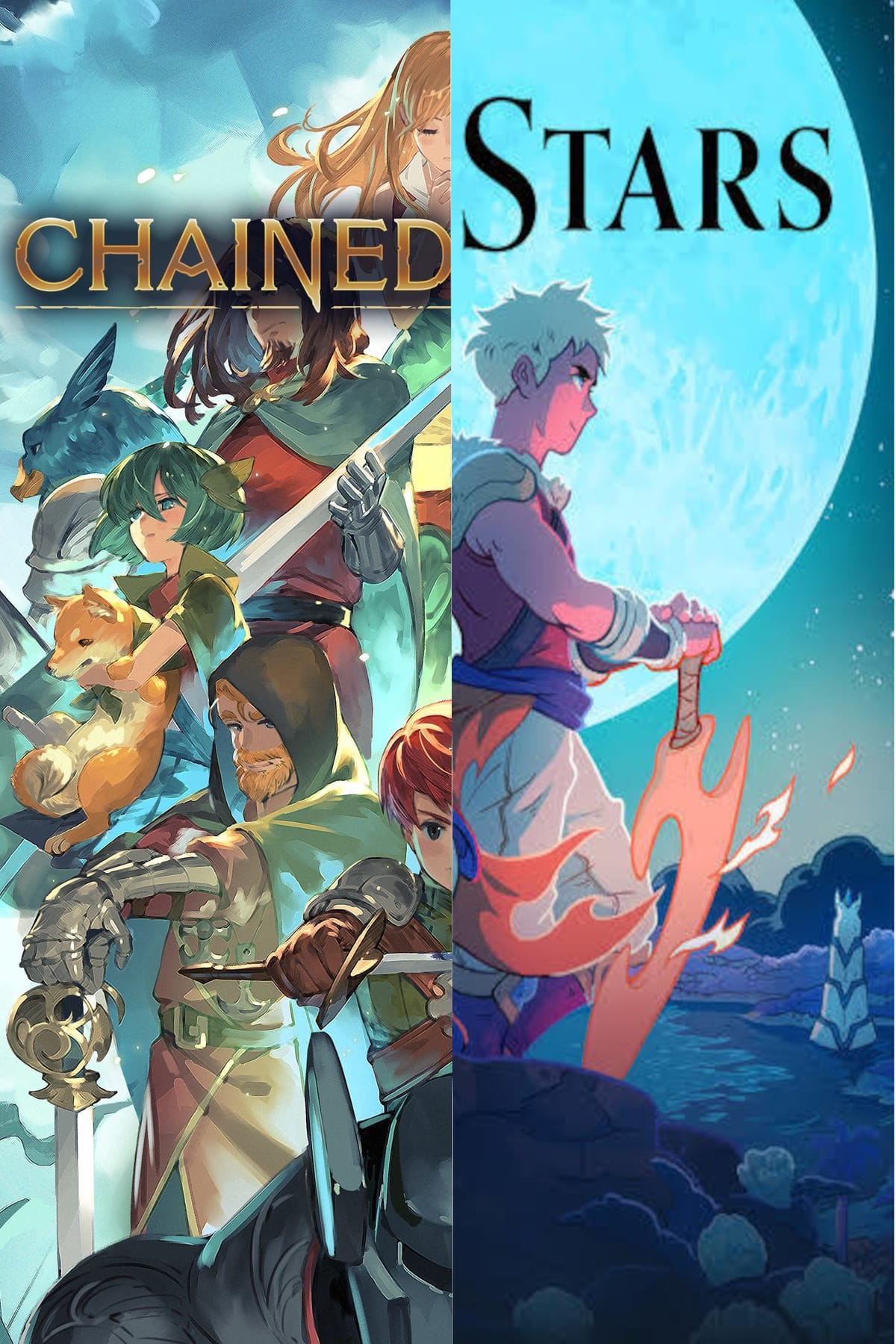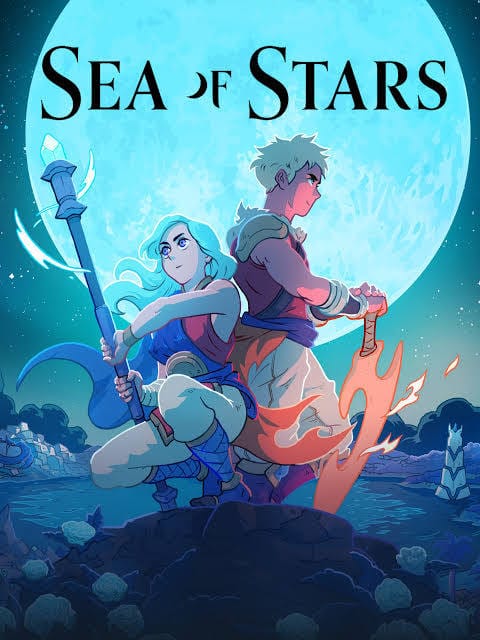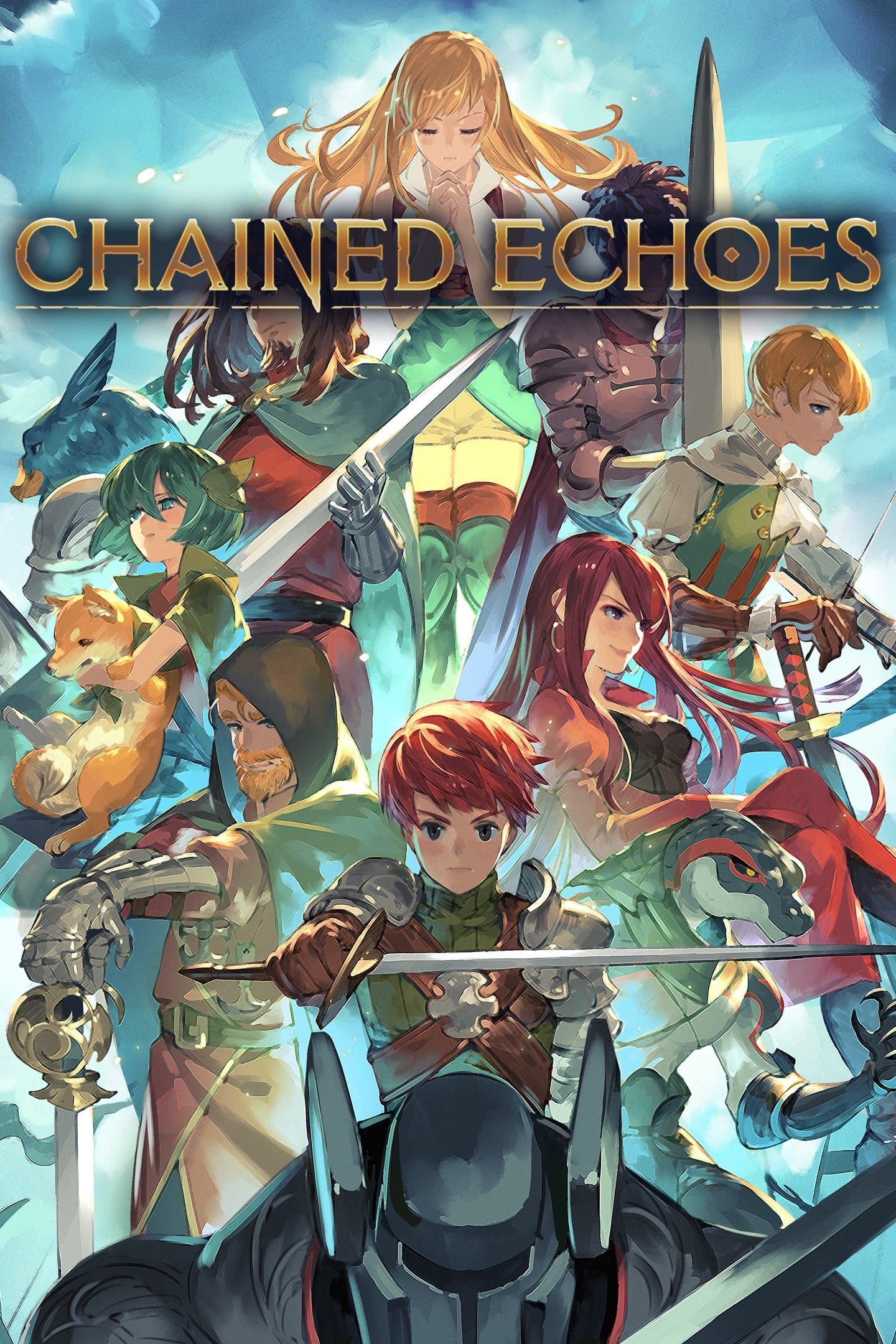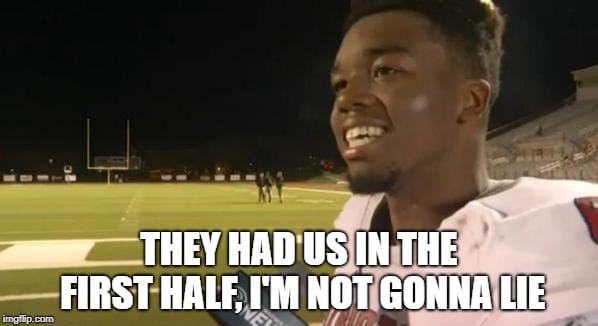Chained Echoes and Sea of Stars

Two incredible "Throwback JRPGs" came out within the last 2 years, and I just played them back to back as my RPG of choice on the Steam Deck. Both are indie RPGs of critical acclaim, both came out within a year of each other, and both have the DNA of SNES RPGs . I can easily recommend either to anyone who asks "Hey, I missed out on Final Fantasy 6/Chrono Trigger/Mario RPG and want to try one, but am afraid of older games and their crufty design."
Sea of Stars was designed by Sabotage Studios, of The Messanger fame, and Chained Echoes was designed by Matthias Linda, more or less solo. The reason I'm combining them into one essay is that they are worth dissecting as branching paths of game design evolution. I will say I beat Chained Echoes in November of 2023, and this will be my post mortem on Sea of Stars, which I earned the True Ending while writing this. So even if one is much fresher in my memory, this blog didn't exist late last year so I'd like to use this as a chance to talk about Chained Echoes. I'll be looking at their stories, their game mechanics, and their overall design philosophies, including how they handle the postgame content, since that's a major part of RPG design. I'll start with Sea of Stars, the indie game of the year winner for 2023, since I just beat the last boss last night.

Story
Sea of Stars follows the story of Valere and Zale, two children who were born with access to Eclipse Magic. They journey together with Garl, the Warrior Chef, and a character who is on my "Best Boys of All Time" list up there with Hector from Fire Emblem 7 and Steven Universe. The three pick up other party members along the way, and their goal is to defeat the Dwellers, otherworldly monsters created by The Fleshmancer, and seal them away. The plot has some incredible twists, as well as a gut punch or two, and I can say that I cried at one point in the story (which isn't unheard of but is more rare these days, so good job gang!)
I'm going to try to not spoil anything about the story while commenting and criticizing, so if you're sensitive I suggest skipping down to the next section(Gameplay) for your own safety.
I really adore what Sabotage Studios did here, evidince being that this game made me cry with how good the story is. I will fully admit that I started writing this before hitting the "True ending", and that was because of a foolish requirement: Getting all the hidden collectibles in the game, the Rainbow Conch Shells. Putting the real ending of the game behind a grind is TOTALLY an SNES RPG thing to do, but I was hoping that in the year of our lord 2024 we'd be past the need to do tedious tasks in video games that act as annoying roadblocks to victory. By the end of the game I naturally found 35 of these, which meant I needed to go around scooping up another 25, and using a guide wasn't perfect since I didn't remember which ones I got and which I missed.
This game actually draws a lot from one of the GOAT games, Final Fantasy 7, in that they actually kill off a playable character in the main story. It also takes the story tool from Final Fantasy Tactics, where the game is being narrated, and adds a wonderful twist to that which I applaud the narrative design team for. There is a clear halfway point in the game, and this follows in the footsteps of Final Fantasy 6 in that there is a whole new world for the player to explore in that second half. This new world is a sci-fi dystopia that houses The Fleshmancer and the last Dweller. The story doesn't pull this out of it's ass either, giving a character a second moment to shine by telling players that this new world is where she's from. This is good, but the problem is that the second half of the game feels... padded out story wise. In this new world the game loses a LOT of steam for me primarily because the plot becomes a series of minor goals to achieve before facing off against the big bad. The whole spires part of the game feels like they needed an extra dungeon to pad the game length with, and it didn't feel like a natural progression of the plot. And with that, I'll take a sledgehammer to the transition into gameplay.
Gameplay
This game starts with an interesting turn order system: You have full control over which party member attacks in what order, each getting one action per round. Every time you take an action all the enemy timers tick down and when they hit 0 their turn triggers, and at the start of the next round they line up a new attack with a new countdown timer. This gets augmented throughout the game with Locks, which act as a lock-key system with your attacks, each having a property (Like blunt, slash, poison, sun, moon, and arcane) that will appear and you have to match your attacks to the Locks. The last note on turn order is that enemies get added that ignore the one attack per round of combat limitation.
HP isn't restored until you heal it with food, spells, or at a campsite. MP regenerates at 3mp per regular attack. Early on, you get the ability to generate magic orbs from enemies you strike with basic attacks, and use those orbs to give your attacks an extra element based on the character who absorbs the orb. The game tells you to not fear using MP, and in fact the best part of the game is that it encourages you to never have a full bar of MP. Every action you take fills up the combo meter, and there are 3 charges to it. Every character combination has a combo attack that costs a variable amount of these charges depending on the effect (My most used was the full party heal for 2 points with Zale/Valere.) Every time you level up you get a Mario & Luigi like choice of one stat to get an extra boost in, though you're limited to only 4 of the 6 major stats every level.
The last combat system notation I'll put here is the Relic system. These are all sorts of options ranging from easy mode (Double HP and auto heal out of combat) to hard mode(reduce all party members HP by 95% and make perfectly timed guards required). There are all sorts of tweaks to have here, like an assist mode that gives you visual confirmation when you correctly time something, or a relic that makes it so you automatically time hits/guards perfectly, but only get half the bonus for using it. This makes the experience totally tailored to the player, and none of them have any judgement attached to them, which is refreshing!
Outside of combat, the team brings a great understanding of "Keep It Simple Stupid" by giving the player only 3 tools to use on every puzzle. The first is a puff of air that can send blocks flying, as well as turn windmills. The second is the ability to change the time of day with the shoulder buttons, which is mostly used to activate light switches. The final item is the grappling hook which lets you fly towards ladders, anchor points, and enemies to initiate combat. At camp, the player learns how to cook food, and you are limited to 10 food items which can be used inside or out of combat. You can also get a little story time at Teaks to flesh out the world building. There is also the Wheels minigame, which actually slaps. It's basically a roulette game where you have 5 roulette wheels that you can pull 3 times, and after each pull you can lock in the slots you want to keep. The more you match, the more resources you get, and if you get enough then you'll attack the enemy's side. These systems balance the pacing of the game, weaving combat, platforming puzzles, and camp downtime really helps keep the player engaged.
The only main critique of Sea of Stars is that the combat shines in boss fights, but there are entirely too many filler encounters in each level. The issue with all timed input RPG systems is that they add interactivity to every combat ability, but that adds stress to the combat flow. YIIK (A game I could rant against for hours) didn't understand this and the normal attacks in that game took about 10 seconds each, which makes most combat last forever. Sea of Stars only has this issue with some of the spells, like Valere's Moonerang and Serai's Venom Flurry skills, which can last almost 20 seconds if done correctly. You never want to feel tired with a game's main systems, but by the end of Sea of Stars I was very ready to never have to Moonerang again.
Summary
Sea of Stars is one of those games that does basically everything right. The art is incredible, the animation fun and snappy, the music engaging, and the gameplay is tight. This game learned all the right lessons from Super Mario RPG in the gameplay department, Final Fantasy 6/7 in it's story, and The Messenger in it's vibes. After 100% completion I can say that the extra bosses were more or less endurance battles which were the capstone test to combat and the terrible rainbow conch quest. The only criticisms I have for the title are "Too many random enemies," which is a JRPG staple, and "The story drags when you get to the dark world" and that's partially due to them wanting to make you feel like hope is lost. My last note on my personal experience is that my cousin gifted me a copy through steam, and I didn't even know that the game was made by Sabotage Studios until he asked me if I hit "The Messenger" level yet. The extra layer of care that was added by this social connection for me really sent the game into the stratosphere as far as feelings go.
Note: I went back to get the true ending of Sea of Stars and can firmly say it was very cute and I liked it, but I wish I spent my time just watching the ending and then moving onto other things. I liked that you got a capstone story for each character, and that you make the world much better than the basic ending. I recommend having a Rainbow Conch guide up during your play through if you're going for true story completion.

Story
Chained Echoes is a wide party narrative, meaning to start the game you'll be bouncing between character introductions until you have them all slam together and form a group. The party will slowly grow throughout the adventure, finally reaching 12 members. Additionally, even though Glenn and Lenne could be argued to be the protagonists, each character has their own story that ties into the main plot. This leads to a deep, interconnected story where most breathers in the story actually lead to fleshing out a character's backstory or giving you more insight into your party members. Even the later characters who join you have been observed throughout the story, so when they join the party you understand their reasoning.
Chained Echoes is still a JRPG though, which means you start the game fighting rabbits or goblins and by the end of the game you're slaying gods through the power of friendship. This is the agreed upon trope of almost every JRPG out there, but at least Chained Echoes starts you off in giant robots and then takes them away immediately. This is great for the pacing of the game, because it shows you the potential of your characters at their best, and gives you the promise where if you play long enough you'll get back in the robot.
This story goes in all sorts of directions, dealing with themes of reincarnation, ending cycles of abuse, the lengths one would go to save a loved one, weapons of mass destruction, and what happens when you're the last one standing. It threads the needle between being very serious and having some levity until the end of the game where it's just a desperate dash to the finish. It's been months since completing the game and I still smile when I see the little sprites of the characters (Except you Robb. You know what you did Robb.) I don't remember there being many drags in the story, and that's probably because the game systems let you take breaks in the plot to do side content, and when you're finally ready for more plot you can just dive right back in. Oh, hey, look, another sledgehammer!
Gameplay
This is another RPG that has densely layered systems, and they all link together to make a wonderful mix, like a seven layer bar of video game. I'll start with the leveling system, which is broken into two main parts. Grimoire Shards(GS) are given out as a reward for bosses and unique monsters, and thus one of the power tracks of the game isn't grindable. Every GS you obtain can be spent on active skills of which you have 8 slots for, passive skills, which you have 5 slots for, and stats. Early on you want to invest in abilities to fill those open slots, and as you win battles you're rewarded Skill Points. Part of your earned SP gets directly fed into your equipped skills and another part goes into a bank for you to spend for that character to instantly level up a skill. Leveling up a skill increases the potency coefficient, reduces the cost of the skill, or some other effect that is described.
The other main power systems are player equipment and character classes. Equipment is usually bought at shops and improved with resources. Improving equipment gives you more slots for you to customize the gear with crystals you find in your adventure. I'm not going to elaborate much on crystals, since they're complicated, but basically they give you specific enhancements that certain characters really need to shine (for example, more status, elemental affinities, status attacks, etc). Classes are unlocked at statues, and they require you to beat a challenge to obtain them. Classes give characters access to specialization, like the cleric class giving passive TP bonuses and active healing spells. When you master a class skill your character knows it forever, so swapping classes or using your SP on class skills are recommended to get your characters more specialized or more well rounded, depending on what you need.
The combat is just as interwoven as every other part of the game, so I'll break it down piece by piece. First of all, it's not an active input system, so you just need to focus on your strategy, not pressing the button at the right time. You have 4 active character slots in combat, and 2 characters per slot. You can swap out in combat, but make sure that's what you want to do since you can't immediately swap back. The top right of the screen has the turn order, so you can plan your actions out a few turns out. In the top left there is the overdrive gauge, which is the special sauce of the combat. Every skill you have has a skill type: Physical/magical attack, buff, debuff, healing, and utility. There are three zones of the overdrive gauge; yellow is neutral, green is overdrive, and red is overheat. If you're in Overdrive you deal more damage, take less damage, and skills cost less, and if you're Overheated the opposite is true. This means that managing the gauge is key to combat, and if you overheat you'll be in big trouble. Every attack action fills the gauge, both allies and enemies attacks and skills fill it much more quickly. To reduce the gauge you must match your attack to the currently active skill type, guard, or swap to a back row member.
As you can see from the above paragraphs, what this game lacks in active time it makes up for in strategy. Every turn matters, and since your HP/TP recharge after every fight the system is balanced around having your characters hold nothing back every combat. I will admit I actually lost to normal enemies in this game, because I was trying new skills out and suddenly I was in overheat and rabbits were murdering me. That said, halfway through the game you get access to GIANT ROBOTS and you know I went back to those rabbits and stomped them for their insolence.
Another system that is tied to progression is the reward board. It's like a mini achievement system that pushes players to complete challenges for rewards. Killing unique monsters, opening chests, exploring, and more can unlock tiles on the board. Chaining these rewards together get you even better rewards, guiding the player without really pressuring them into doing absolutely everything. This was admittedly one of the grinds of the game, especially when one went back to an area where enemies were under leveled.
The endgame content is centered around getting everyone's ultimate weapons and armor as well as a series of escalating fights that leads to a secret boss that I would argue isn't as difficult as some of the bosses leading up to it. This content is technically isn't postgame, since you can do it before or after beating the last boss. You don't get anything aside from seeing and beating the secret boss from all the fights, but pushing the game's combat systems is usually what these sorts of bosses are designed for.
Summary
If Undertale is to Earthbound, then Chained Echoes is to Chrono Trigger, and that's a high bar to hit. In my opinion Chained Echoes clears the bar handily, giving the player a compelling story, a rewarding combat system, and a lot of entertainment in such a tidy package. Honestly it's kind of incredible that this game was built by mostly one person, because it's really solid if you can enjoy most of the systems. Chained Echoes earned its comparison to Undertale, and beats out Undertale if what you're seeking is closer to a mainline Final Fantasy than it's quirky counterpart. It has all the inherent flaws of a JRPG, but that is something that you need to accept before playing any game in that genre.
So, Why put these Games Together?
First and foremost, I just wanted to dig back and discuss Chained Echoes, and pairing it with another throwback RPG was the easiest way to do that. That said, I think these two titles show that two different teams can draw upon the same inspirations and get two completely different outputs. Both stories take rather normal people, forced by their circumstances to save the world. They both have turn based RPG systems and gorgeous 2d art styles. They have memorable characters, endgame content, and combat systems. That said, the two games are also extremely different in all the ways it matters.
In a sentence for each of them:
Sea of Stars is a game inspired by SNES RPGs, but with a focus on modernized active gameplay that pulls the characters into a personal, heartfelt story.
Chained Echoes is a game inspired by SNES RPGs, but with a focus on strategy and character building that has a huge cast of characters who all fit into the puzzle like story.

Sure, both games have similarities, but they are both extremely high quality video games that are very worth the time of anyone who is interested in feeling what it was like to play Chrono Trigger back when it was contemporary. That said, people have opinions, and I'm sure there is some armpit of the internet arguing over which is better. I'm honestly happy that both exist because I have a deep love of this style of game and not enough of them are being release in the modern era. I don't believe that players need to see 100% of what the game has to offer in either, considering the internet exists and you can just watch those extra completion bonuses. I did it because I have this weird compulsion with this style of game to get all the things; to have all my characters maxed out in Final Fantasy 5, attacking 8 times per round casting the most powerful magic in the game. The idea of totally mastering the game systems to the point of destroying all sense of game balance is my favorite, and both Chained Echoes and Sea of Stars are too tightly designed for this godlike state to exist in.
And that wraps up another article. I mostly use these to explain how the games work, my feelings on the game, and hope that these insights are useful to you readers. I'm just trying to use describing video games as a hook to get people to enjoy the things I enjoy, as well as cracking the bone and sucking the marrow out of whatever game I just completed. I hope to keep this up into the future, since these articles have been really good for getting more out of the games I play.